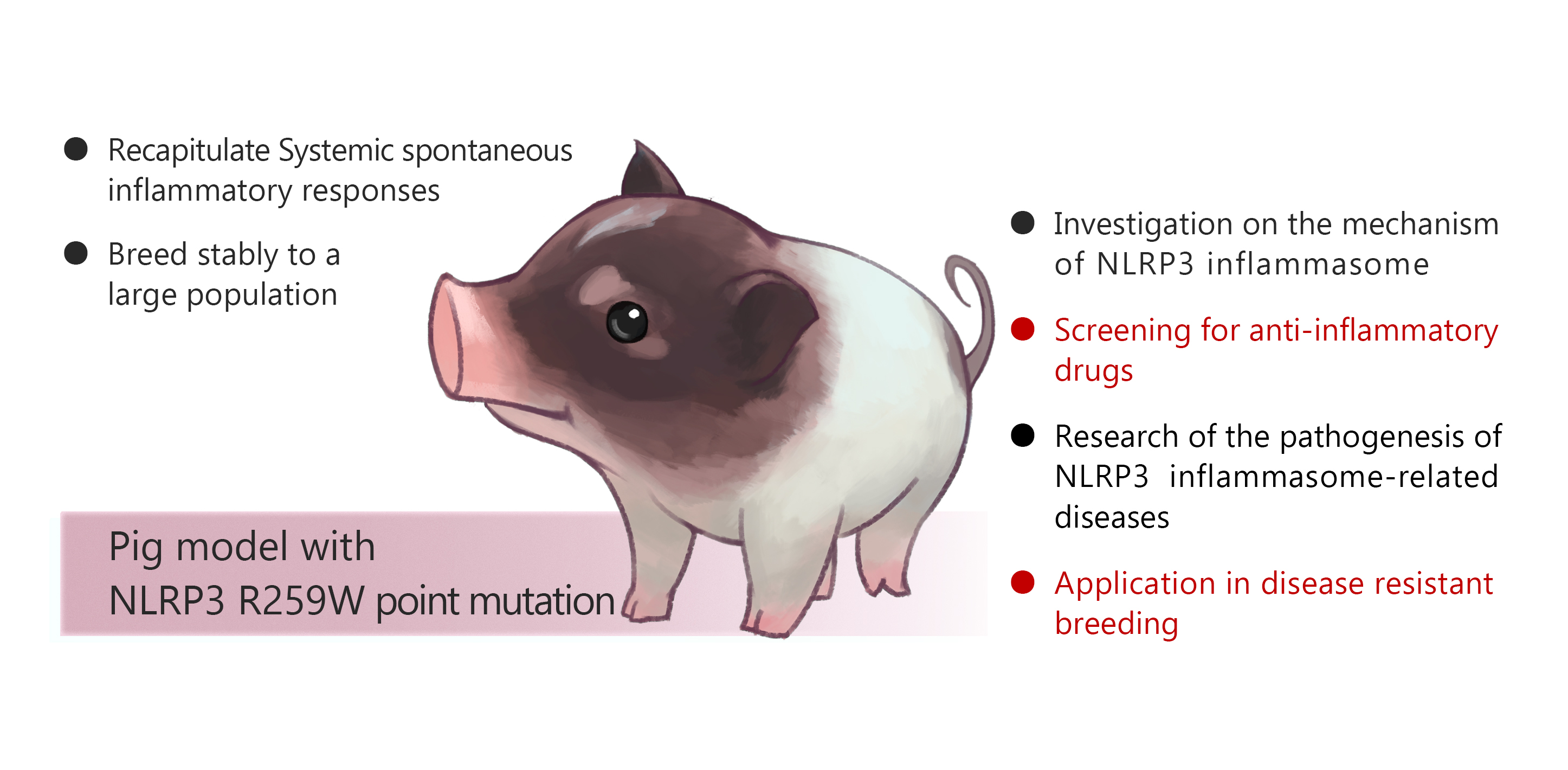Researchers Successfully Established the World's First Pig Model with Systemic Spontaneous Inflammatory Responses
On 1st November, Lai Liangxue’s research team from the Guangzhou Institutes of Biomedicine and Health, Chinese Academy of Sciences, Xiao Lei’s research team from the Zhejiang University, and Meng Guangxun’s research team from the Institute Pasteur of Shanghai, Chinese Academy of Sciences jointly published a research paper titled “Engineered pigs carrying a gain-of-function NLRP3 homozygous mutation can survive to adulthood and accurately recapitulate human systemic spontaneous inflammatory responses” in The Journal of Immunology. By using CRISPR/Cpf1-mediated genome editing and somatic nuclear transfer technology, the study established an NLRP3 gain-of-function pig model carrying a homozygous R259W mutation, which accurately exhibited human spontaneous systemic inflammation symptoms.
As an integral part of innate immune system, NLRP3 inflammasome is at the core of inflammatory reaction and it can be activated by pathogens of various types and physicochemical signals. Since NLRP3 inflammasome plays a critical role in the progression of inflammation-related diseases, it has become a new target for treating various inflammatory diseases. It was found in patients that an amino acid mutation in NLRP3 protein, namely the 260th amino acid mutating from arginine (R) into tryptophan (W), can cause excessive activation of inflammasomes, leading to systemic spontaneous inflammation. To date, there is no effective treatment for this disease. And the elucidation of its occurring mechanism and the development of new treating methods require proper animal models. At present, the animal model of the disease is mice, but the signaling pathways of the NLRP3 inflammasome of mice is very different from that of humans. Therefore, the mouse model cannot fully manifest the symptoms of human spontaneous inflammatory diseases. However, the NLRP3 inflammasome activation in pigs is similar to that in humans, so the research team chose pigs as experimental subjects to develop an animal model that can model human spontaneous inflammatory diseases more accurately.
The researchers combined the CRISPR/Cpf1 technology with single-stranded oligonucleotides in somatic cells to introduce a nonsynonymous mutation (CGG>TGG) that lead to R-to-W amino acid substitution in the 259th region of the NLRP3 protein, obtaining the cell colonies harbored the NLRP3 R259W-point mutation . The scientists used one of the cell colonies as a nuclear donor and successfully established the NLRP3 mutant pigs through the somatic nuclear transfer technology. Like human patients, NLRP3 pigs with either homozygous mutant pigs or heterozygous mutation have showed typical symptoms of spontaneous systemic inflammation syndrome. The severity of symptoms varies on different individuals. While many individuals suffered early death caused by spontaneous inflammation, about half of the individuals can develop to sexual maturity, making it possible tobreed a large-scale pig population with NLRP3 R259W point mutation.
The pig model with enhanced activation of NLRP3 inflammasomes obtained by the research teams provides an ideal animal model for the screening of anti-inflammatory drugs. It will also be a tool for the research of the occurring and progressing mechanism of a series of NLRP3 inflammasome-related diseases, such as familial cold autoinflammatory syndrome, type 2 diabetes, Alzheimer’s disease and atherosclerosis. What’s more, the model also serve as a research tool for the use of natural immunity against foreign viruses/bacteria, and has a potentialapplicationin the fields of disease resistant breeding.
The co-corresponding authors of the paper are associate researcher Wang Kepin, principal investigator Meng Guangxun and principal investigator Lai Liangxue. Doctoral students Li Wenjing and Shi Lei from the School of Animal Science of the Zhejiang University, and Zhuang Zhenpeng, a doctoral candidate of GIBH, and Dr. Wu Han, assistant researcher of GIBH, are the co-first authors. The research is supported by a number of projects such as the National Key Research and Development Programme, the Major Projects of Genetic Modification, the Biology Island Lab, the Innovation Unit of the Chinese Academy of Medical Sciences, and the Youth Innovation Promotion Association of the Chinese Academy of Sciences.

Pig model with NLRP3 R259W point mutation
Contact:
Liangxue Lai, Ph.D., Principal Investigator
Guangzhou Institutes of Biomedicine and Health, Chinese Academy of Sciences
E-mail: lai_liangxue@gibh.ac.cn
Link:https://www.jimmunol.org/content/205/9/2532
Attachment Download:
-
Contact
-
Reference
-
Related Article